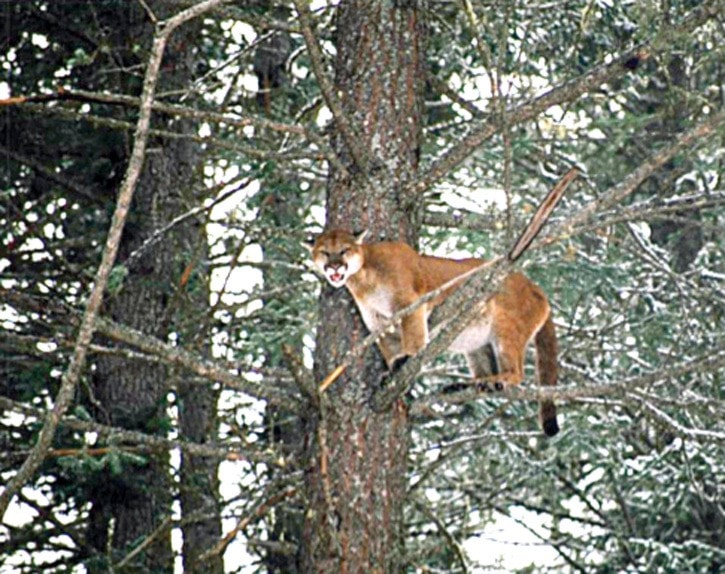Approximately 60 local residents packed the Horsefly community hall Sunday, Feb. 5 to listen to conservation officers Sergeant Ken Owens and Sergeant Len Butler give a public awareness presentation about cougars.
It was an excellent informative session, and many of us learned a few things we were not aware of, and had other notions either reaffirmed or dispelled.
There are approximately 4,000 cougars in B.C.
Female cougars mature at about two to three years, and breed any time of the year. Once they have cubs, they take care of them for about one and a half to two years.
Females cover an area of about 15 kilometers square, and males occupy an area of about 25 kilometers square, and will often range as far as 50 kilometers in any direction.
These areas are not shared, and in fact are guarded ferociously, by both sexes.
The average weight of full grown males is about 125 pounds and the female 100 pounds. The largest male ever recorded was in Arizona where a 276 pound cougar was taken.
There are three subspecies of cougars.
The Vancouver Island cougars are slightly smaller than our cougars in the Cariboo, and more orange in colour.
Recent cougars taken in the Horsefly area average around 175 pounds.
Cougars will measure nine feet in length, which includes a three-foot tail.
Cougars can leap 15 feet into a tree, and can leap 30 feet after their prey.
Cougars prey primarily on mice, deer, porcupine, beaver, rabbits, moose, elk, wild sheep, mountain goats, black bear cubs, grouse, coyote, other cougar, domestic stock and household pets.
It is believed the household pets resemble wild animals enough to stimulate the predatory instinct of the cougars.
This is believed to be why children are sometimes attacked.
Human attacks are extremely rare, although the resulting publicity after such an attack makes it seem worse than it really is.
An individual has about a 2.2 million to one chance of being attacked by a cougar if they are in cougar country.
There is no relocation program for a cougar that is venturing too close to your home. They will hunt your pets, and the COs want you to report a problem cougar immediately, and they will attend the scene and make a decision to deal with your problem.
We are encouraged to keep our pets in at night, and sheep and goat owners who are most commonly the people bothered by cougar predation are encouraged to lock their animals in a barn at night with no access through the loft — the same with your chickens.
These kinds of livestock are beacons for your local cougar, which are for the most part night hunters, preferring early dusk and early morning to hunt.
Like your house cat, cougars are either full or sleepy or out hunting.
After a kill, they drag the prey to a secure location and cover it with leaves and other debris, urinate on and around it, and go to cover not far away.
If you come across one of these kills, move away immediately while keeping a wary eye on the surroundings.
If you have a face to face encounter, never turn your back on the cougar, or run.
Spread your jacket out to appear large, speak calmly and with authority telling the cougar what a gorgeous animal you think it is, and back away until you are sure you are away, and then you can run like heck.
We were shown how to determine the sex of a cougar by looking up at them from under the tree they are in.
This was extremely interesting. However, I personally don’t care if they are male or female, but I can inform you that the female sex organ is about one inch from her anus, and the male gonads about three inches.
I fail to see why I need to know this, but there it is for your information.
The screaming I heard at the hatchery on Horsefly Lake when I was a kid was a female cougar in heat.
There were four of us kids, and the hair stood straight up on all of us as we raced home in complete terror!
The males will hiss and growl, but it is the females you hear screaming on the TV ads. I refuse to comment on any resemblance in their species to ours.
In the same manner dogs and wolves mark their territory, cougars mark their areas with piles of debris, which they urinate or defecate on at significant points of their claimed turf.
Other cats respect this, and the males use it to find a route where they can be around to breed different females.
Cougars are polygamous, with one male serving several females.
It is estimated that 14-20 average size mule deer will feed one cougar annually, less if supplemented with coyote or moose.
Cougars eat the muscle tissue, heart, lungs, liver, and sometimes meat from the ribs, but unlike the canny Scots, leave the stomach and intestines.
Clearly they haven’t heard about haggis.
Some people mistake their dog tracks for a cougar sign.
Cougars’ claws retract, so do not show; their rear foot pad has three distinct oval impressions similar to the sea scallop shell edge used by Shell Oil, only smaller, of course. This is opposed to your dog imprint which is a flatter impression.
When in doubt call your CO.
The number for the Williams Lake conservation officers is 250-398-4569 or 1-877-952-7277.
